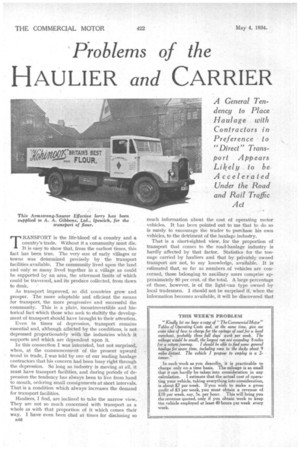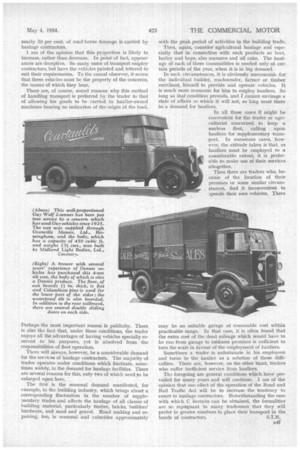Problems of the
Page 60

Page 61

If you've noticed an error in this article please click here to report it so we can fix it.
HAULIER and CARRIER TRANSPORT is the life-blood of a country, and a country's trade. Without it a community must die. it is easy to show that, from the earliest times, this fact has been true. The very size of early villages or towns was determined precisely by the transport facilities available. The community lived upon the land
and only so many lived together in a village as could be supported by an area, the uttermost liMits of which could be traversed, and its produce collected, from dawn to dusk.
As transport improved, so did countries grow and prosper. The more adaptable and efficient the means for transport, the more progressive and successful the community. This is a plain, incontrovertible and historical fact which those who seek to stultify the development of transport should have brought to their attention.
Even in times of depression, transport remains essential and, although affected by the conditions, is not depressed proportionately with the industries which it supports and which are dependent upon it.
In this connection I was interested, but not surprised, when, at the commencement of the present upward trend in trade, I was told by one of our leading haulage contractors that his concern had been busy right through the depression. So long as industry is moving at all, it must have transport facilities, and during periods of depression the tendency has always been to live from hand to mouth, ordering small consignments at short intervals.
That is a condition which always increases the demand for transport facilities.
Hauliers, I find, are inclined to take the narrow view. They are not so much concerned with transport as a whole as with that proportion of it which comes their
way. I have even been chid at times for disclosing SO 46
much information about the cost of operating motor vehicles. It has been pointed out to me that to do so is surely to encourage the trader to purchase his own vehicles, to the detriment of the haulage industry.
That is a short-sighted view, for the proportion of transport that comes to the road-haulage industry is hardly affected by that factor. Statistics for the tonnage carried by hauliers and that by privately owned transport are not, to my knowledge, available. It is estimated that, so far as numbers of vehicles are concerned, those belonging to ancillary users comprise approximately 80 per cent, of the total. A large percentage of those, however, is of the light-van type owned by local tradesmen. I should not be surprised if, when the information becomes available, it will be discovered that nearly 50 per cent, of road-borne tonnage is carried by haulage contractors.
I am of the opinion that this proportion is likely to increase, rather than decrease. In point of fact, appearances are deceptive. So many users of transport employ contractors, but have the vehicles painted and lettered to suit their requirements. To the casual observer, it seems that these vehicles must be the property of the concerns, the names of which they bear.
There are, of course, sound reasons why this method of handling transport is preferred by the trader to that of allowing his goods to be carried in haulier-owned machines bearing no indication of the origin of the load.
Perhaps the most important reason is publicity. There is also the fact that, under these conditions, the trader enjoys all the advantages of having vehicles specially reserved to his purposes, yet is absolved from the responsibilities of fleet operation.
There will a..hvays, however, be a considerable demand for the services of haulage contractors. The majority of trades operates under conditions which fluctuate, sometimes widely, in the demand for haulage facilities. There are several reasons for this, only two of which need to be enlarged upon here. '
The first is the seasonal demand manifested, for example, in the building industry, which brings about a corresponding fluctuation in the number of supplementary trades and affects the haulage of all classes of building material, particularly timber, bricks, builders' hardware, and sand and gravel. Road malting and repairing, too, is seasonal and coincides approximately with the peak period of activities in the building trade.
Then, again, consider agricultural haulage and espee daily that in connection with such products as beet, barley and hops, also manures and oil cake. The haulage of each of these commodities is needed only at certain periods of the year, when it is in big demand.
In such circumstances, it is obviously uneconomic, for the individual builder, roadinender, fanner or timber merchant, himself to provide and operatevehicles. It is much more economic for him to employ hauliers. So long as that condition prevails, and I cannot envisage a state of affairs in which it will not so long must there be-a demand for hauliers.
In all those cases it might be convenient for the trader or agriculturist concerned to keep a nucleus fleet, calling upon hauliers for supplementary transport. In numerous cases, however, the attitude taken is that, as hauliers must be employed to a considerable extent, it is preferable to make use of their services altogether.
Then there are traders who, because of the location of their premises or some similar circumstances, find it inconvenient to eperate their own vehicles. There may be no suitable garage at reasonable cost within practicable range. In that case, it is often found that the extra cost of the dead mileage which would have to be run from garage to buSiness premises is sufficient to turn the scale in favour of the employment of hauliers.
Sometimes a trader is unfortunate in his employees and turns to the haulier as a solution of those difficulties. There are, however, on the other hand, traders who suffer inefficient service from hauliers.
Ths foregoing are general conditions which have prevailed for many years and will continue. I am of the opinion that one effect of the operation of the Road and Rail Traffic Act will be to increase the tendency to resort to haulage contractors. Notwithstanding the ease with which C licences can be obtained, the formalities are so repitT,nant to many tradesmen that they will prefer in greater numbers to place their transport in the hands of contractors. S.T.R.




























































































